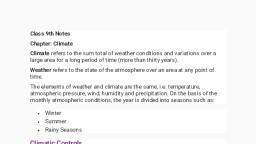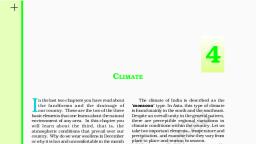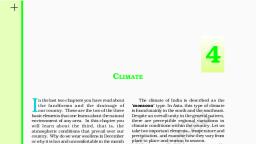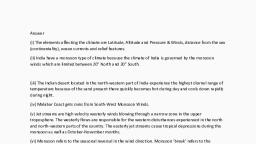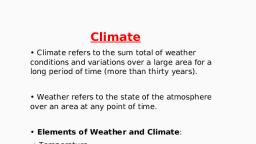Page 1 :
CLIMATE
Page 2 :
Climate refers to the sum total of weather conditions and variations over a large area for a long period of time (more than thirty years), Weather refers to the state of the atmosphere over an area at any point of time. The elements of weather and climate are the same,, ELEMENTS OF WEATHER AND CLIMATE are SAME temperature, atmospheric pressure, wind, humidity and precipitation., The word monsoon is derived from the Arabic word ‘mausim’ which literally means season. • ‘Monsoon’ refers to the seasonal reversal in the wind direction during a year. The climate of India is described as the ‘monsoon’ type, Describe the regional variations in climatic conditions in India., Or, Give examples of climatic contrasts in India, 1.In summer, the mercury occasionally touches 50°C in some parts of the Rajasthan desert, whereas it may be around 20°C in Pahalgam in Jammu and Kashmir. On a winter night, temperature at Drass in Jammu and Kashmir may be as low as minus 45°C. Thiruvananthapuram, on the other hand, may have a temperature of 22°C. between day and night temperatures., 2.In the Thar Desert the day temperature may rise to 50°C, and drop down to near 15°C the same night. On the other hand, there is hardly any difference in day and night temperatures in the Andaman and Nicobar islands or in Kerala., 3. While precipitation is mostly in the form of snowfall in the upper parts of Himalayas, it rains over the rest of the country. , 4.The annual precipitation varies from over 400 cm in Meghalaya to less than 10 cm in Ladakh and western Rajasthan. Most parts of the country receive rainfall from June to September. But some parts like the Tamil Nadu
Page 4 :
CLIMATIC CONTROLS �or
Page 6 :
Latitude: The tropic of cancer passes through the middle of the country from the Rann of Kuchchh in the west to Mizoram in the east. almost half of the country, lying south of the tropic of cancer, belongs to the tropical area. all the remaining area, north of the tropic, lies in the sub-tropics. therefore, India’s climate has characteristics of tropical as well as subtropical climates.
Page 10 :
TROPICAL CLIMATE
Page 11 :
Altitude: height above sea level .�For every 165 meters there is a decrease in temperature by 1°C Its is also known as normal Lapse rate
Page 13 :
RELIEF AS A FACTOR AFFECTING CLIMATE
Page 14 :
Himalayas act as climatic divide or climate Barrier
Page 15 :
WHY WINDS MOVE? , Uneven heating of the Earth by the sun. ... Differences in atmospheric pressure generate winds.
Page 16 :
PRESSURE AND WINDS
Page 17 :
PRESSURE AND WINDS
Page 19 :
LAND TO LAND WINDS ARE DRY, Water to land are wet winds
Page 20 :
Pressure and surface winds�IN CONTEXT TO INDIA, In summer, due to high temperature, low pressure area develops over interior Asia and over North- Western India. Air from high pressure areas and Southern Indian ocean blow and crosses the equator and turns right towards this low pressure region resulting in complete SEASONAL reversal of wind direction. , During winter, there is a high-pressure area north of the Himalayas. Cold dry winds blow from this region to the low-pressure areas over the oceans to the south., These winds gather large moisture and bring widespread rainfall over the mainland of India.
Page 21 :
PRESSURE AND SURFACE WINDS, They carry moisture hence no rain or very little rain. , , During winter, high pressure areas develop over the areas of North Himalayas. This causes cold dry winds blow from the area over the oceans towards low-pressure area over the oceans to the south. , , India lies in the region of north westerly winds. These winds originate and blow over land during winter from the sub tropical high pressure tropical belt. These winds blow south, get deflected to the right due to the Coriolis force and move towards the equatorial low pressure region.
Page 22 :
An apparent force caused by the earth’s rotation. The Coriolis force is responsible for deflecting winds towards the right in the northern hemisphere and towards the left in the southern hemisphere. This is also known as ‘Ferrel’s Law’.
Page 23 :
JET STREAMS, Jet Streams are high speed steady winds blowing in upper narrow belt of high altitude (above 12,000 m) westerly winds in the troposphere.��• Their speed varies from about 110 km/h in summer to about 184 km/h in winter., The Sub-Tropical Jet stream plays a significant role in both hindering the monsoon winds as well as in quick onset of Indian monsoons., The burst of monsoons depends upon the upper air circulation which is dominated by Sub Tropical Jet Streams (STJ)., � Jet streams also play role in determining the weather by separating colder air and warmer air., The easterly jet stream steers the tropical depressions into India. These depressions play a significant role in the distribution of monsoon rainfall over the Indian subcontinent. The tracks of these depressions are the areas of highest rainfall in India. The frequency at which these depressions visit India, their direction and intensity, all go a long way in determining the rainfall pattern during the southwest monsoon period., In winters, In summers
Page 24 :
UPPER AIR CIRCULATION, The upper air circulation of the Indian Sub-continent is dominated by a westerly flow which is governed by Jet stream. Due to their location over 27`30` N latitude, these jet streams are known as Sub-tropical westerly jet streams. They blow south of the Himalayas, throughout the year except in summer.
Page 25 :
WESTERN CYCLONIC DISTURBANCES, The western cyclonic disturbances are weather phenomena of the winter months causing rain brought in by the westerly flow from the Mediterranean region. They usually influence the weather of the North and north western regions of India., USE FUL RAIN IN PLAIN SNOW IN MTS, RAIN VERY GOOD FOR WHEAT CROP, In summer, the sub tropical westerly jet stream moves North of Himalayas due to apparent shifting of the sun. An easterly jet stream, called sub- tropical easterly jet stream.
Page 27 :
Movement of jet streams
Page 28 :
Ocean currents as a factor of climate control
Page 29 :
Warm currents increase the temperature of surrounding areas and cold decrease the temperature
Page 31 :
MECHANISM OF MONSOON, 1. Differences in heating and cooling of land and sea (land gets heated rapidly and sea takes time in absorbing and releasing heat) creates low pressure area on land and high pressure area over the sea., �2. The shift of ITCZ zone over the Ganga Plains during summers, �3. The presence of high pressure area to the east of Madagascar, �4. Intense heating of the Tibetan Plateau, �5. Movement of jet streams
Page 32 :
2. INTER TROPICAL CONVERGENCE ZONE, A narrow zone near the equator where northern and southern air masses converge, typically producing low atmospheric pressure.
Page 33 :
MECHANISM OF MONSOON, 3.The presence of the high-pressure area, east of Madagascar (approx. 20 degree S over the Indian Ocean. The intensity and position of this high pressure area affects the Indian monsoon.
Page 34 :
MECHANISM OF MONSOON, 4.The Tibetan plateau gets intensely heated during the summer. This results in strong vertical air current and the formation of low pressure over the plateau above 9km above the sea level.
Page 37 :
Normally, when the tropical eastern south pacific ocean experiences high pressure, the tropical eastern Indian Ocean experiences low pressure., But in certain years, there is a reversal in the pressure conditions and the eastern pacific has low pressure in comparison to the Indian Ocean., This periodic change in pressure conditions is known as Southern Oscillation (SO)., The difference in pressure over Tahiti, in the Pacific Ocean and Darwin in northern Australia is computed to predict the intensity of the monsoon., A feature connected with the SO is the El Nino, a warm ocean current that flows past the Peruvian coast, in place of the cold Peruvian current every 2 to 5 years., The changes in pressure conditions are connected to the El Nino. Hence, the phenomena is referred to as ENSO (El Nino Southern Oscillations).
Page 39 :
ONSET OF MONSOONS, The duration of the monsoon is between 100- 120 days from early June to mid-September. Around the time of its arrival, the normal rainfall increases suddenly and continues constantly for several days. This is known as the ‘burst’ of the monsoon, and can be distinguished from the pre-monsoon showers. The monsoon arrives at the southern tip of the Indian peninsula generally by the first week of June. Subsequently, it divides into two – the Arabian Sea branch and the Bay of Bengal branch., The Arabian Sea branch reaches Mumbai about ten days later on approximately the 10th of June. This is a fairly rapid advance. The Bay of Bengal branch also advances rapidly and arrives in Assam in the first week of June. The lofty mountains cause the monsoon winds to deflect towards the west over the Ganga plains. By mid-June the Arabian Sea branch of the monsoon arrives over Saurashtra- Kuchchh and the central part of the country. The Arabian Sea and the Bay of Bengal branches of the monsoon merge over the north-western part of the Ganga plains. Delhi generally receives the monsoon showers from the Bay of Bengal branch by the end of June (tentative date is 29th of June).
Page 42 :
THE INDIAN MONSOON, Monsoon winds strongly influence the climate of wind. The monsoons are experienced in the tropical area roughly between 20 degree N and 20 degree S.
Page 43 :
SUMMER SEASON, The summer season is from March to May. During this period, the global heat belt shifts towards north because of the apparent northward movement of the sun., During summer, the temperatures rise and air pressure falls in the northern part of the country. Towards the end of May, an elongated low-pressure area develops in the region which extends from the Thar Desert in the northwest to Patna and Chhotanagpur in the east and southeast., A characteristic feature of the hot weather season is the ‘loo’. These are strong, gusty, hot and dry winds(what) which blow during the day over the north and northwestern India.(where?) (when ? march to may), Dust storms are very common in northern India during the month of May. This is also the season of localized thunderstorms; accompanied by violent winds, torrential downpours, and hail., Pre-monsoon showers are common towards the end of the summer season; especially in Kerala (where?)and Karnataka. They are often called ‘mango showers’ as they help in the early ripening of mangoes. (What? When?)
Page 44 :
ADVANCING MONSOON, The rainy season begins from early June., The low-pressure condition over the northern plains intensifies at this time. It attracts the trade winds from the southern hemisphere. These south-east trade winds cross the equator and blow in a south-westerly direction to enter the Indian peninsula as the south-west monsoon. These winds bring abundant moisture to the subcontinent., These winds blow at an average velocity of 30 km/h. The monsoon winds cover the country in about a month; barring the extreme north-west., The windward side of the Western Ghats receives very heavy rainfall, early in the rainy season. The Deccan Plateau and parts of Madhya Pradesh also receive some rain, in spite of lying in the rain shadow area., The north-eastern part of the country receives the maximum rainfall of this season. Mawsynram (Meghalaya) receives the highest average rainfall in the world., Rainfall in the Ganga valley decreases from east to west. Rajasthan and parts of Gujarat get scanty rainfall., Monsoon tends to have ‘breaks’ in rainfall; which means that there are wet and dry spells in between. The monsoon rains take place only for a few days at a time and then come the rainless intervals. These breaks in the monsoon are because of the movement of the monsoon trough. The trough and its axis keep on moving northwards or southward due to various reasons. The movement of the monsoon trough determines the spatial distribution of rainfall., The monsoon is famous for its uncertainties. It may cause heavy floods in one part of the country, and may be responsible for droughts in other part. Because of its uncertain behaviour, it sometimes disturbs the farming schedule in India. This affects millions of farmers all over the country.
Page 45 :
RETREATING MONSOON, During October-November, the sun apparently moves towards the south. During this period, the monsoon trough over the northern plains becomes weaker. The south-west monsoon winds weaken and start withdrawing gradually. The monsoon withdraws from the northern plains by the beginning of October., The retreat of the monsoon is marked by clear skies and rise in temperature. While day temperatures are high, nights are cool and pleasant. Humidity is still present. High temperature and humidity, makes the weather quite uncomfortable during the day. This is commonly known as “October Heat”., The temperature begins to fall rapidly in northern India by the second half of October. The low-pressure conditions over northwestern India move to the Bay of Bengal by early November. This shift leads to cyclonic depressions over the Andaman Sea. These cyclones usually cross the eastern coasts of India and cause heavy and widespread rain. These cyclones may also arrive at the Coasts of Orissa, West Bengal and Bangladesh. These cyclones contribute to the bulk of the rainfall of the Coromandel Coast.
Page 46 :
WINTER SEASON, The winter season begins from mid-November and stays till February; in northern India., December and January are the coldest months in the northern part of India. The temperature ranges between 10°-15°C in the northern plains, while it ranges between 24°-25°C in Chennai., The northeast trade winds prevail over the country in this season. As these winds blow from land to sea, most parts of the country experience a dry season., The weather is usually marked by clear sky, low temperatures and low humidity and feeble variable winds., The inflow of the cyclonic disturbances from the west and the northwest is a characteristic feature of the cold weather over the northern plains. , These low-pressure systems originate over the Mediterranean Sea and Western Asia and move into India. , They cause winter rains over the plains and snowfall in the mountains. The winter rainfall is in small amount but is very important for the rabi crop. This rainfall is locally known as mahawat., The peninsular region does not get a well-defined winter because of the moderating influence of the sea.
Page 47 :
TROPICAL CYCLONES, Tropical cyclones occur during the monsoon as well as in October- November and are a part of the easterly flow. These disturbances affect the coastal regions of the country.
Page 48 :
MONSOON AS A UNIFYING BOND, Although there are wide variations in weather patterns across India, the monsoon brings some unifying influences on India., 1. The Indian landscape, its flora and fauna, etc. are highly influenced by the monsoon., 2.The entire agricultural calendar in India is governed by the monsoon. Most of the festivals in India are related to agricultural cycle. These festivals may be known by different names in different parts of the country, but their celebration is decided by the monsoon. , 3.It is also said that the river valleys which carry the rainwater also unite as a single river valley unit. Due to these reasons, monsoon is often a great unifying factor in India.
Page 49 :
Distribution of rainfall in india, Areas of high rain fall: Northeastern regions and the windward side of the Western ghats experience an average of 400cm of annual rainfall. Areas like Assam, Meghalaya, Arunachal Pradesh and hilly tracts of the Western Ghats are host to tropical rainforests. The highest rainfall in India and the world is recorded at Mawsynram village of Meghalaya., Areas of medium rain fall :Areas which experience 100 to 200 cm of rainfall include parts of West Bengal, Bihar, Orissa, Madhya Pradesh, Andhra Pradesh, and leeward side of the Western Ghats. Wet Deciduous forests comprise the most common natural vegetation of these regions., Areas of low rainfall: Areas having 50 to 100 cm of rainfall consisting of parts of Maharashtra, Gujarat, Karnataka, Tamil Nadu, Andhra Pradesh, Madhya Pradesh, Punjab, Haryana and Western Uttar Pradesh. Tropical Grasslands, Savannah and Dry Deciduous forests are commonly found in these areas.
Page 50 :
Thank you










